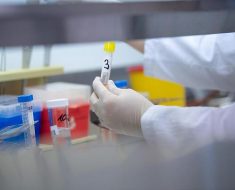This article explores the various causes of a bump on the bottom of the foot and how a person can treat each cause.
Causes
A bump on the bottom of the foot may be caused by:
1. Uneven weight distribution

Sometimes, the long bones behind the toes (metatarsals) become misaligned. This affects the way weight is distributed across the ball of the foot as a person walks.
Uneven weight distribution in the foot means some areas absorb more pressure than others. These may cause calluses to form on the ball of the foot.
Bumps caused by uneven weight distribution tend to occur in people with diabetes.
If a person with diabetes develops lumps or calluses on their feet, they should monitor them carefully and speak to a doctor. If left untreated, these lumps can cause ulcers.
Foot ulceration is the most common lower-extremity complication for people with diabetes.
2. Limited movement of the big toe joint
If a person’s big toe joint does not move correctly when they walk, an excessive force is applied to the bottom of their big toe.
A callus may develop under their big toe and the bone may become enlarged.
3. Plantar fibromas
Plantar fibromas are nodular masses that can form in the arch of a person’s foot.
These non-cancerous tumors form in the plantar fascia, which is the ligament in the arch of the foot.
Researchers are unsure why some people get plantar fibromas, but risk factors include tendon damage, a medication called Dilantin, and genetics.
4. Dyshidrotic eczema
Dyshidrotic eczema may cause bumps on the bottom of the foot that are itchy and filled with fluid.
Doctors do not know what causes this type of eczema, but it has been linked to allergies and stress. Dyshidrotic eczema can also cause skin that is:
- flakey
- cracked
- painful to touch

Treatment for a bump on the bottom of the foot varies depending on the cause.
Treatments for each cause are explored below:
Limited movement of the big toe joint
A doctor may recommend functional foot orthosis for someone with limited movement of their big toe joint.
This treatment helps to restore normal movement in the joint. Once the joint can move properly, it relieves the pressure under the big toe, and a person can treat the callus.
Uneven weight distribution
A molded insole or orthotic can help treat bumps caused by uneven weight distribution. This helps to remove the pressure from the balls of the feet.
Plantar fibromas
Foot orthotics may relieve pressure from the arch of the foot (plantar fascia) and help reduce the size of the nodules.
It is also possible to remove the mass surgically. However, to ensure the plantar fibromas do not come back, it may be necessary to remove most of the plantar fascia.
A person may need to wear orthotics after surgery.
Dyshidrotic eczema
A doctor may prescribe corticosteroids or antihistamines for dyshidrotic eczema. Reducing stress may also help treat dyshidrotic eczema.
Plantar warts
Plantar warts do not usually need treatment. However, if they bleed, change color, or cause noticeable discomfort, a person should speak to their doctor. The doctor can determine whether they should be removed.
There are many ways to remove warts. A 2006 study notes that cryotherapy, which involves using liquid nitrogen to remove the wart, has the highest quality of clinical evidence to support its effectiveness.
Bursitis
People can treat bursitis with:
- rest
- anti-inflammatory medications
- ice
If the condition does not improve, a doctor may recommend corticosteroids and physical therapy. Surgery may be needed in severe cases.
Cysts
A doctor can drain cysts using a sterile needle. For more significant cysts, surgery may be needed. Unlike blisters, it is not a good idea to try to drain a cyst at home.
Synovial sarcoma
A synovial sarcoma is malignant and always requires medical treatment. A surgeon can also remove it using surgery. A person may also need chemotherapy or radiotherapy to help recovery.
Haglund’s deformity
A person can often treat Haglund’s deformity with home remedies, such as:
- wearing open back shoes
- taking anti-inflammatory medications
- icing the area to reduce inflammation
If home remedies are not effective, the following treatments are available:
- ultrasound treatment
- soft tissue massage
- orthotics
- heel pads
- immobilizing boots
Surgery is also an option if other treatments are not effective.

Takeaway
There are several different causes of a bump on the bottom of the foot. Understanding these helps a person determine why they have one and take the best course of action.
It is always a good idea to speak to a doctor to get a proper diagnosis. A doctor can recommend an appropriate treatment and steps a person can take to prevent bumps from occurring in the future.
Source: Read Full Article





